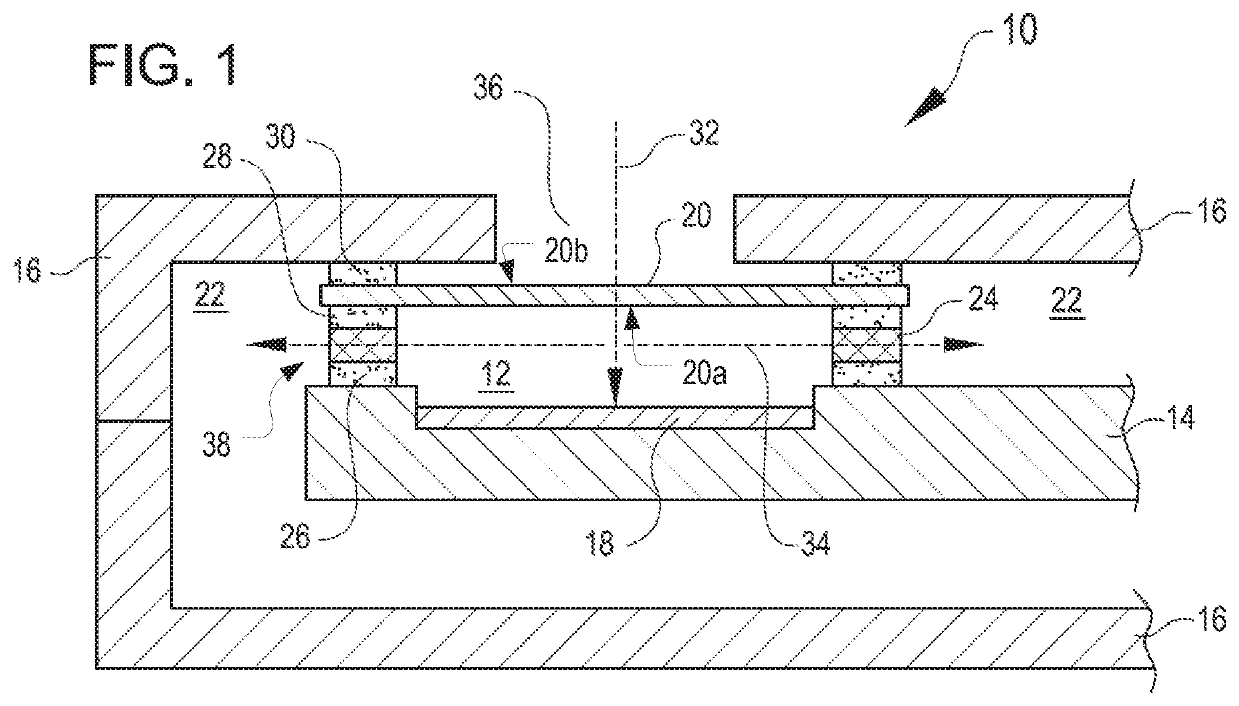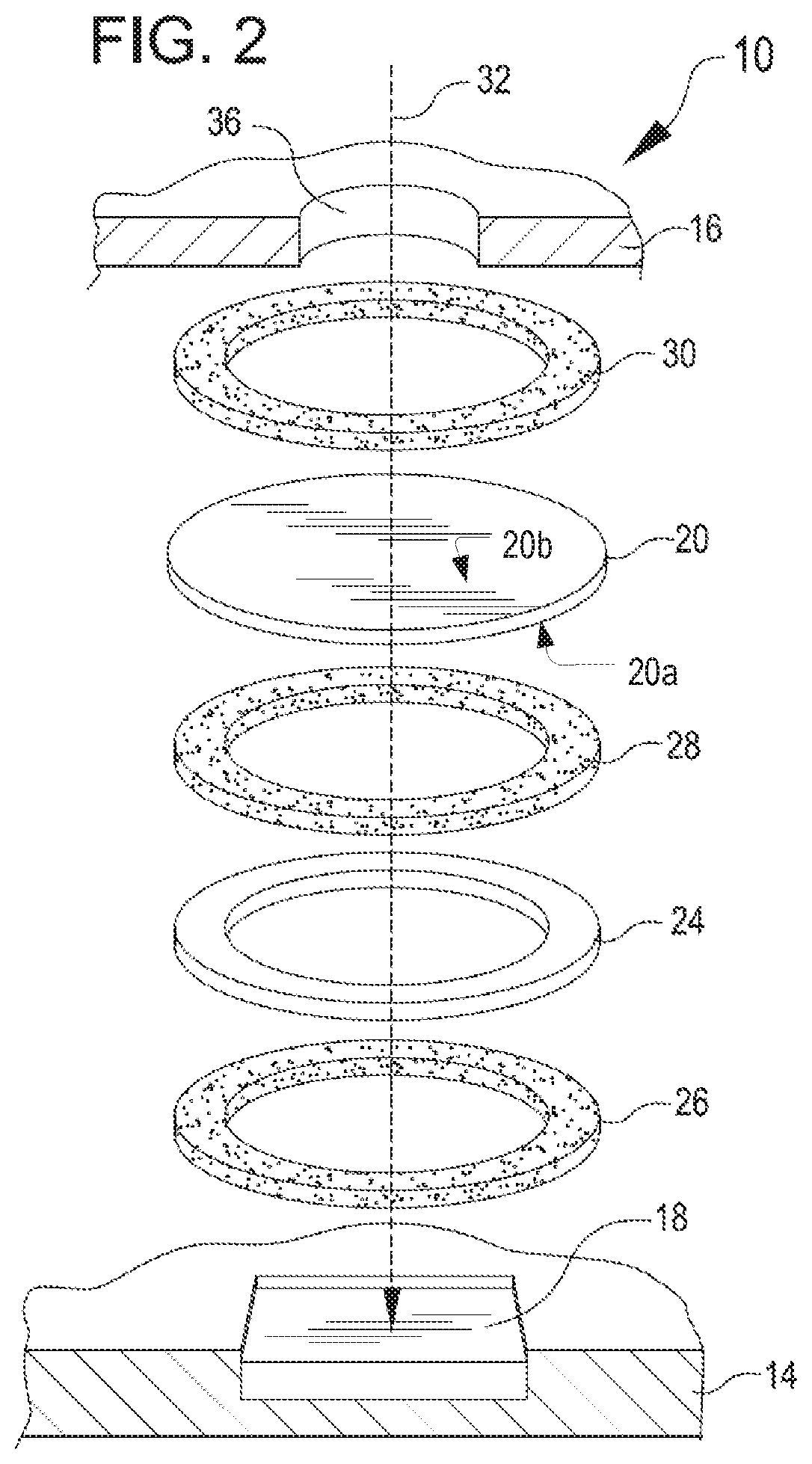Pressure equalizing construction for nonporous acoustic membrane
a technology of pressure equalization and acoustic membrane, which is applied in the direction of transducer casing/cabinet/support, electrostatic transducer, semiconductor transducer, etc., can solve the problems of reducing the design ability to equalize air pressure around the acoustic device, affecting the sensitivity of acoustic devices, and many acoustic cover designs that are unsuitable for some environments. , to achieve the effect of reducing th
- Summary
- Abstract
- Description
- Claims
- Application Information
AI Technical Summary
Benefits of technology
Problems solved by technology
Method used
Image
Examples
example 1
[0062]Assemblies similar to the arrangement of FIG. 1 were assembled to assess the venting rate of various additional breathable layer materials, as detailed below in Table 1. In airflow tests, the sample assemblies were reversed and clamped against an orifice of a steel plate, such that air could be passed through the orifice into the acoustic cavity. An ATEQ® Premier D Compact Flow Tester was used to measure airflow rate (mL / min) out of the acoustic cavity (i.e. through the breathable layers) by challenging it with 1 psi of air pressure through the orifice in the steel plate.
[0063]In pressure equilibration tests, each sample assembly was connected with a simulated microphone cavity containing a first pressure transducer, and attached (sealed) to the simulated microphone cavity at ambient pressure. The simulated microphone cavities and sample assemblies were inserted into a pressure vessel, along with second pressure transducers outside the simulated microphone cavities. The pressu...
example a
[0065]An acoustic protective cover assembly was constructed using five layers. The first layer was a ring of double-sided self-adhesive tape consisting of a PET backing and a tackified acrylic adhesive (TESA® 4972, 48 μm thick). The second layer was stacked on top of the first layer. The second layer was a continuous non-porous polymeric film. The third layer was stacked on top of the first and second layers. The third layer was a ring of double-sided self-adhesive tape consisting of a PET backing and a tackified acrylic adhesive (TESA® 4983, 30 μm thick). The fourth layer was stacked on top of the first three layers. The fourth layer was a ring of woven material (Milliken & Company, Part number 170357). The fifth layer was stacked on top of the first four layers. The fifth layer was a ring of double-sided self-adhesive tape consisting of a PET backing and a tackified acrylic adhesive (TESA® 4983, 30 μm thick). This assembly was tested for pressure equilibration, ATEQ airflow, and a...
example b
[0066]An acoustic protective cover was constructed of five layers as described in Example A. However, layer four of the sample was a polyester non-woven material (Hollytex®, Ahlstrom Corporation, Grade: 3254, 0.102 mm thick). This assembly was tested for pressure equilibration, ATEQ airflow, and acoustic insertion loss. The orientation of the sample was such that the fourth layer was closest to the pressure transducer, air pressure source, or microphone respectively. This sample had an adequate pressure equilibration time as evidenced by a 3.06 second exponential time constant. This sample also had an acceptable airflow rate of 22 mL / min and an acoustic response without the presence of an insertion loss peak.
PUM
 Login to View More
Login to View More Abstract
Description
Claims
Application Information
 Login to View More
Login to View More - R&D
- Intellectual Property
- Life Sciences
- Materials
- Tech Scout
- Unparalleled Data Quality
- Higher Quality Content
- 60% Fewer Hallucinations
Browse by: Latest US Patents, China's latest patents, Technical Efficacy Thesaurus, Application Domain, Technology Topic, Popular Technical Reports.
© 2025 PatSnap. All rights reserved.Legal|Privacy policy|Modern Slavery Act Transparency Statement|Sitemap|About US| Contact US: help@patsnap.com



